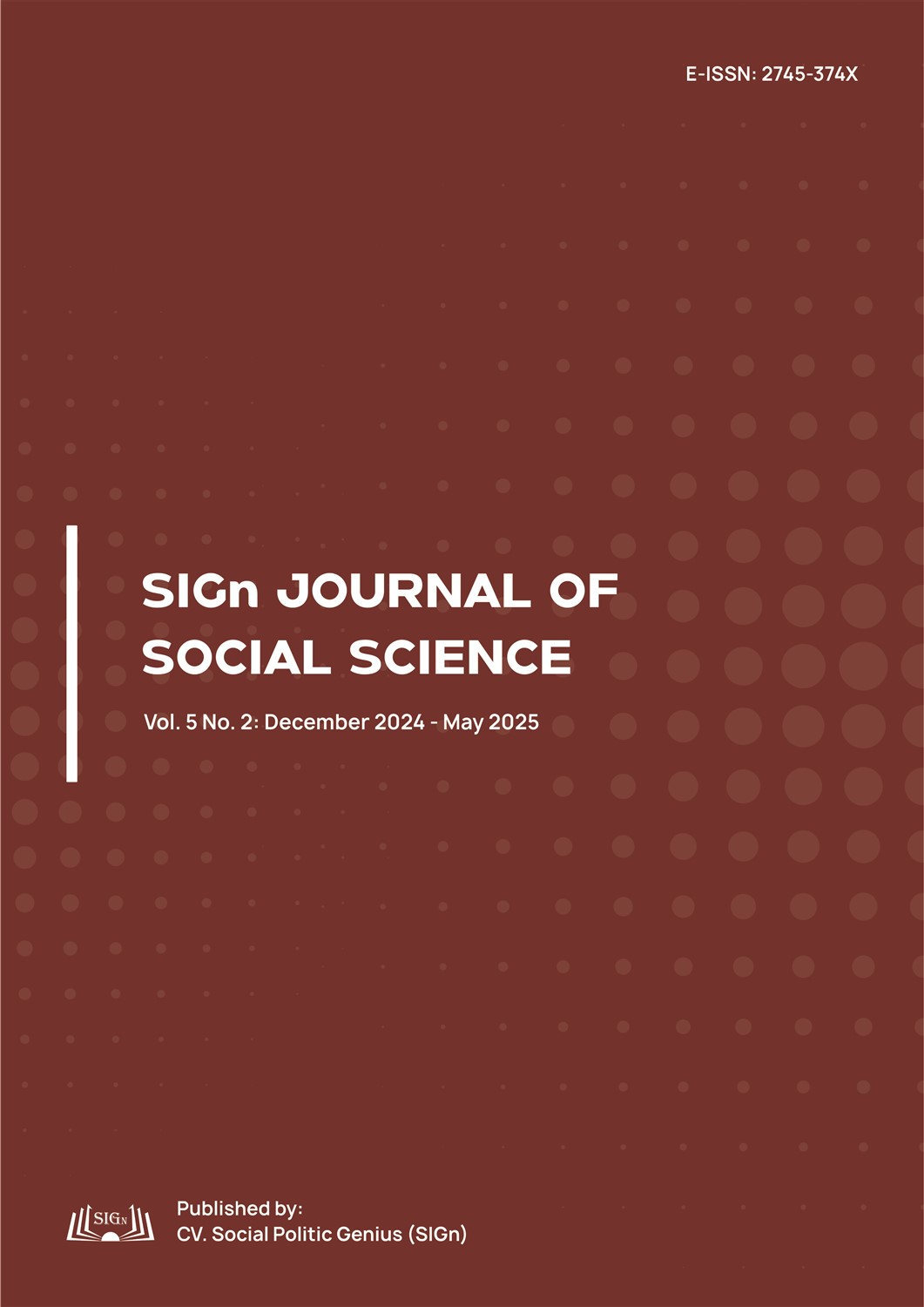Jilbab: The Interplay of Ideology, Dress Code, and Consumerism
Abstract
The jilbab, transcending its status as a symbol of religious observance for Muslim women, is now a complex global phenomenon fraught with contested meanings and practices. This research aims to analyze how contemporary jilbab practices and representations are dynamically negotiated at the crucial intersection of ideological forces (religious and political), the logic of dress semiotics as a sign system, and the penetration of global consumer culture. Using a qualitative approach relying on Barthesian semiotic analysis alongside thematic and content analysis of textual and visual data (literature, media, documentation), this study unpacks the interaction of these three dimensions. Findings indicate that the jilbab functions as a visual text with non-singular meanings; diverse styles communicate different and often ambiguous semiotic significations, which are continuously constructed and contested within the ideological arena through struggles over religious interpretation, identity politics, and feminist discourses. Furthermore, it was found that intensive commodification processes through the fashion industry and media have integrated the jilbab into the logic of consumer culture, creating tensions between values of piety, aesthetic expression, and consumptive desire. It is concluded that a holistic understanding of the contemporary jilbab necessitates an interdisciplinary analysis that moves beyond simplistic dichotomies, recognizing the jilbab as a dynamic site of Muslimah identity negotiation amidst the complex interplay of ideology, the dress sign system, and global market hegemony.
Downloads
References
Abdullah, I. (2001). Seks, Gender & Reproduksi Kekuasaan. Tarawang Press.
Abdullah, I. (2006). Konstruksi dan Reproduksi Kebudayaan. Pustaka Pelajar.
Adrian, M. (2011). The Veil: Women Writers on Its History, Lore, and Politics. Contemporary Islam, 5(1), 95-96. https://doi.org/10.1007/s11562-010-0118-7
Alamgir, A. (2014). Islam and Women’s Rights: Discourses in Malaysia. Procedia - Social and Behavioral Sciences, 114, 872-876. https://doi.org/10.1016/j.sbspro.2013.12.800
Barthes, R. (1972). Mythologies (Trans. by A. Lavers). The Noonday Press.
Barthes, R. (1977). Elements of Semiology (Trans. by A. Lavers & C. Smith). Hill and Wang.
Barthes, R. (1983). The Fashion System (Trans. by M. Ward & R. Howard). Hill and Wang.
Bornioli, A., Birenboim, A., Druez, E., Livny, O., Noll, J. v. d., Mayer, N., & Bloom, P. B.-N. (2023). Environmental Appraisals in Outgroup Cultural Landscapes: The Role of Muslim Elements in Urban Settings. Cities, 143, 1-9. https://doi.org/10.1016/j.cities.2023.104579
Budiman, K. (2002). Di Depan Kotak Ajaib: Menonton Televisi Sebagai Praktik Konsumsi. Galang Press.
Damayanti, I., & Rahayu, N. I. (2017). The Effect of Muslim Women’s Sportswear (Jilbab) to Dehydration Level and Thermoregulation After Exercise. In Proceedings of the 1st Annual Applied Science and Engineering Conference (AASEC), in conjunction with The International Conference on Sport Science, Health, and Physical Education (ICSSHPE) 2016 (Vol. 108, pp. 1-4). IOP Conference Series: Materials Science and Engineering. https://doi.org/10.1088/1757-899X/180/1/012204
Fargues, P. (2005). Women in Arab Countries: Challenging the Patriarchal System? Reproductive Health Matters, 13(25), 43-48. https://doi.org/10.1016/S0968-8080(05)25161-3
Febriani, D. H. (2022, February 22). 4 Negara yang Melarang Jilbab, dari Turki hingga India. SindoNews. Retrieved February 18, 2025, from https://international.sindonews.com/read/693549/43/4-negara-yang-melarang-jilbab-dari-turki-hingga-india-1645524168
Fitrysaleh, A. (2019). Jilbab Sebagai Ibadah (Studi Fenomenologi pada Polisi Wanita Polres Baubau). Diktum: Jurnal Syariah dan Hukum, 17(1), 87-101. https://doi.org/10.35905/diktum.v17i1.666
Geertz, C. (1973). The Interpretation of Cultures. Basic Books.
Ghasemi, A. (2015). Muslim Iranian Women Working in Broadcast Media (IRIB): Between Motherhood and Professionalism. Women’s Studies International Forum, 53, 167-173. https://doi.org/10.1016/j.wsif.2015.01.003
Glapka, E. (2018). Veiled or Veiling? - Turning Back the Gaze on the Western Feminist. Understanding Hijab from the Socio-Culturally Located Positions of Knowing. Women’s Studies International Forum, 71, 103-113. https://doi.org/10.1016/j.wsif.2018.07.008
Grace, D. (2004). The Woman in the Muslin Mask: Veiling and Identity in Postcolonial Literature. Pluto Press. https://doi.org/10.2307/j.ctt183q4r8
Guindi, F. E. (1999). Veil: Modesty, Privacy and Resistance. Bloomsbury Publishing.
Hamzah, N. A., & Abidin, Z. (2021). Jilbab dalam Pandangan Ulama Klasik dan Kontemporer (Kajian Filosofis dan Implementatif). Al-Hikmah, 23(2), 1-14. https://doi.org/10.24252/al-hikmah.v23i2.22462
Hamzeh, M. (2017). FIFA’s Double Hijabophobia: A Colonialist and Islamist Alliance Racializing Muslim Women Soccer Players. Women’s Studies International Forum, 63, 11-16. https://doi.org/10.1016/j.wsif.2017.06.003
Hancock, C., & Mobillion, V. (2019). “I Want To Tell Them, I’m Just Wearing a Veil, Not Carrying a Gun!” Muslim Women Negotiating Borders in Femonationalist Paris. Political Geography, 69, 1-9. https://doi.org/10.1016/j.polgeo.2018.11.007
Hardyanti, W. (2019). Penerimaan Khalayak Terhadap Tayangan Infotainment Tentang Fenomena Artis Lepas Jilbab (Studi Pada Mahasiswi Muslimah di Malang Berdasarkan Kelompok Sosial). Aristo, 7(2), 296-322. https://doi.org/10.24269/ars.v7i2.1757
Heath, J. (Ed.). (2008). The Veil: Women Writers on Its History, Lore, and Politics. University of California Press.
Hoffman, M., & Rosenberg, E. (2023). Religious Behavior and European Veil Bans. Politics, Groups, and Identities, 11(4), 854-875. https://doi.org/10.1080/21565503.2022.2056491
Human Rights Watch. (2024, February 22). Indonesia: Submission to the UN Committee on Economic, Social and Cultural Rights. https://www.hrw.org/news/2024/02/22/indonesia-submission-un-committee-economic-social-and-cultural-rights
Hussain, S. (2024). Feminist Counter-Authoritarian Political Agency: Muslim Girls Re-generating Politics in India. Women’s Studies International Forum, 102, 1-8. https://doi.org/10.1016/j.wsif.2023.102850
James, H., & Simantob, E. (2021, March 11). Veiled in History: How Women Have Been Covered Up. Swissinfo. Retrieved February 18, 2025, from https://www.swissinfo.ch/eng/culture/veiled-in-history-how-women-have-been-covered-up/46373584
Khoja-Moolji, S. (2015). Reading Malala: (De)(Re)Territorialization of Muslim Collectivities. Comparative Studies of South Asia, Africa and the Middle East, 35(3), 539-556. https://doi.org/10.1215/1089201X-3426397
Lajnah Pentashihan Mushaf Al-Qur’an. (2022). Qur’an Kemenag. https://quran.kemenag.go.id
Lury, C. (1996). Consumer Culture. Rutgers University Press.
Masruri, A. (2021). Pandangan Ulama Klasik dan Kontemporer Tentang Jilbab. Andragogi: Jurnal Pendidikan Islam dan Manajemen Pendidikan Islam, 3(3), 431-447. https://doi.org/10.36671/andragogi.v3i3.238
Maulida, T. V. (2020). Implementasi Qanun No 11 Tahun 2002 tentang Berbusana Islami di Kota Langsa [Bachelor Thesis, Universitas Islam Negeri Sumatera Utara Medan]. Repository UIN Sumatera Utara. http://repository.uinsu.ac.id/11037
Meilani, P. M., & Fatmawati, I. (2022). Simbol dan Identitas: Kebijakan Penggunaan Jilbab Pemerintah Kota Padang terhadap Siswi Muslim dan Non-Muslim. Journal of Citizenship, 1(1), 34-47. https://doi.org/10.37950/joc.v1i1.226
Munawaroh, R., Wulandari, R., & Hasanah, H. (2016). Penggunaan Jilbab Bagi Polwan Perspektif Pemberitaan Harian Republika Edisi Juni-Desember 2013. Sawwa: Jurnal Studi Gender, 12(1), 61-78. https://doi.org/10.21580/sa.v12i1.1468
Navarro-Granados, M., & Llorent-Bedmar, V. (2022). The Spanish Muslim Community’s Views on Terrorism in the Name of Islam and Perceived Discrimination: Socio-Educational Measures. International Journal of Intercultural Relations, 89, 166-182. https://doi.org/10.1016/j.ijintrel.2022.05.009
Neuman, W. L. (2003). Metodologi Penelitian Sosial: Pendekatan Kualitatif dan Kuantitatif (Trans. by E. T. Sofia). PT. Indeks.
Nuraeni, L., & Gumilar, S. (2021). Pelarangan dan Perjuangan: Pemakaian Jilbab Pelajar Putri pada Masa Orde Baru Tahun 1982-1991. Al-Tsaqafa: Jurnal Ilmiah Peradaban Islam, 18(2), 163-175. https://doi.org/10.15575/al-tsaqafa.v18i2.15119
O’Brien, P. (2016). The Muslim Question in Europe: Political Controversies and Public Philosophies. Temple University Press.
Pane, S. R. S. (2021). Ayat-Ayat Jilbab dalam Tafsir Al-Misbah. Ta’dib: Jurnal Pemikiran Pendidikan, 11(2), 52-58. https://doi.org/10.54604/tdb.v11i2.42
Pasrin, M., Qorib, F., & Fianto, L. (2022). Analisis Kritis Pemberitaan Pemaksaan Pengunaan Jilbab bagi Siswi Non Muslim SMKN 2 Padang di Metro TV. Jurnal Nomosleca, 8(2), 217-229. https://doi.org/10.26905/nomosleca.v8i2.8761
Sanusi, A. I. (2024). Community Identification and Response to the Threat of Terrorism in Makassar City. SIGn Journal of Social Science, 5(1), 65-77. https://doi.org/10.37276/sjss.v5i1.346
Scott, J. W. (2007). The Politics of the Veil. Princeton University Press. https://doi.org/10.2307/j.ctt7sgmx
Shirazi, F. (2001). The Veil Unveiled: The Hijab in Modern Culture. University Press of Florida.
Sucipto, A. D. (2021). Kapitalisme dan Komodifikasi Jilbab Syar’i di Kalangan Artis dalam Perspektif Karl Marx. Al-Munqidz: Jurnal Kajian Keislaman, 9(1), 1-14. https://doi.org/10.52802/al-munqidz.v9i1.33
Sukendro, G., Destiarman, A. H., & Kahdar, K. (2016). Nilai Fetisisme Komoditas Gaya Hijab (Kerudung dan Jilbab) dalam Busana Muslimah. Jurnal Sosioteknologi, 15(2), 241-254. https://doi.org/10.5614/sostek.itbj.2016.15.02.7
Susanti, S., & Fahyuni, E. F. (2021). Konsep Jilbab dalam Prespektif Al-Qur’an. Tadrib: Jurnal Pendidikan Agama Islam, 7(1), 124-138. Retrieved from https://jurnal.radenfatah.ac.id/index.php/Tadrib/article/view/6285
Wulandari, L. A., & Fitriani, E. (2021). Buka Tutup Jilbab di Kalangan Siswi SMA. Culture & Society: Journal of Anthropological Research, 2(3), 107-112. https://doi.org/10.24036/csjar.v2i3.69
Yulikhah, S. (2016). Jilbab Antara Kesalehan dan Fenomena Sosial. Jurnal Ilmu Dakwah, 36(1), 96-117. https://doi.org/10.21580/jid.v36.1.1627
Zain, M., Aaisyah, S., Alimuddin, A., Abdillah, A. M., & Fauzi, M. F. B. (2023). Hijab Discourse in Indonesia: The Battle of Meaning Between Sharia and Culture in Public Space. Samarah: Jurnal Hukum Keluarga dan Hukum Islam, 7(3), 1661-1681. https://doi.org/10.22373/sjhk.v7i3.19383
Zamzami, D. Y., & Hardiyanto, S. (2024, February 9). Aceh Keluarkan SE Baru soal Aturan Berpakaian bagi ASN, Salah Satunya Larangan Jilbab Bermotif. Kompas. Retrieved February 18, 2025, from https://regional.kompas.com/read/2024/02/09/083000178/aceh-keluarkan-se-baru-soal-aturan-berpakaian-bagi-asn-salah-satunya?page=all
Zubair, S., & Zubair, M. (2017). Situating Islamic feminism(s): Lived Religion, Negotiation of Identity and Assertion of Third Space by Muslim Women in Pakistan. Women’s Studies International Forum, 63, 17-26. https://doi.org/10.1016/j.wsif.2017.06.002
Copyright (c) 2025 Hendra Hendra, Siti Hajar N. Aepu, Intan Kumbayoni, Hilda Anjarsari

This work is licensed under a Creative Commons Attribution 4.0 International License.


.jpg)













